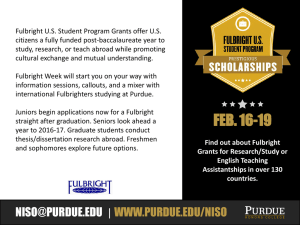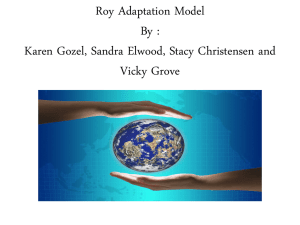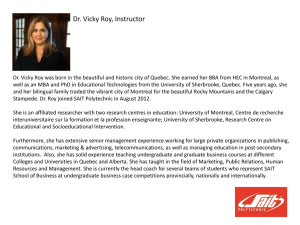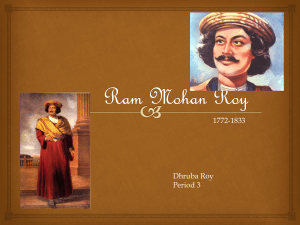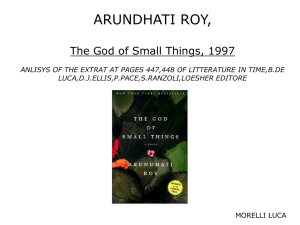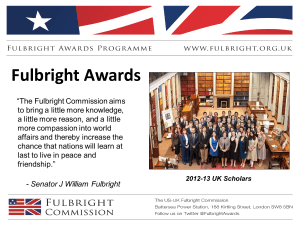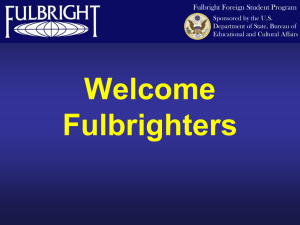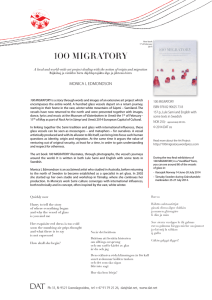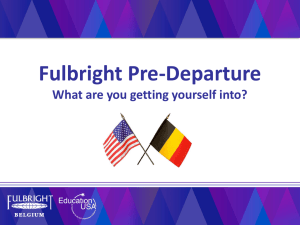An Integrated Approach to Teaching and Learning Physics by
advertisement
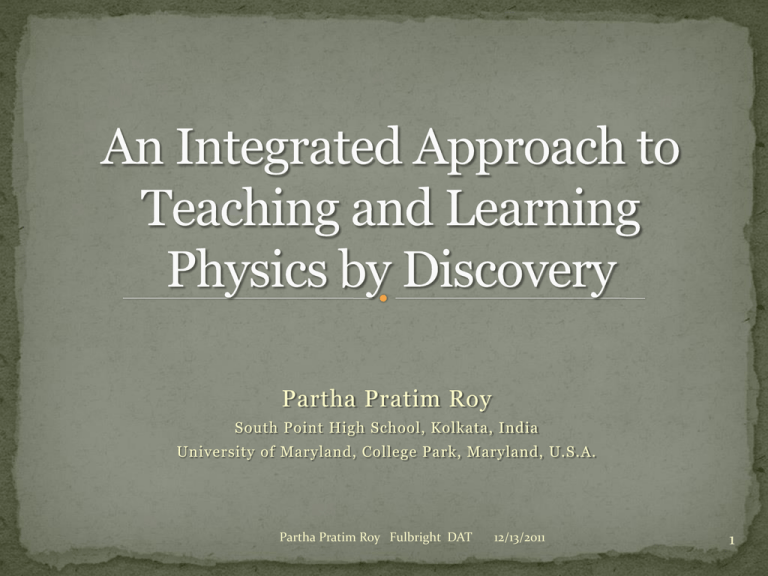
Partha Pratim Roy South Point High School, Kolkata, India University of Maryland, College Park, Maryland, U.S.A. Partha Pratim Roy Fulbright DAT 12/13/2011 1 • What is ‘Discovery Learning’ ? • What is ‘problematic’ about its implementation in a real classroom ? • My study of the problems. • Designing and running a ‘discovery experiment’ in the class. • Findings from the experiment. • Conclusions. Partha Pratim Roy Fulbright DAT 12/13/2011 2 Different people call it in different names • Inquiry driven learning • Constructivist learning • Problem based learning • Experiential learning Partha Pratim Roy Fulbright DAT 12/13/2011 3 John Dewey 1894, 1897, 1916, 1936 Allowing learners to explore things and phenomena mainly by their natural curiosity, and to construct their own knowledge. Minimal guidance or no guidance from the teacher. Partha Pratim Roy Fulbright DAT 12/13/2011 4 J. S. Bruner 1960, J. J. Schwab 1978 “The shrewd guess, the fertile hypothesis, the courageous leap to a tentative conclusion these are the most valuable coin of the thinker at work, whatever his line of work. Can schoolchildren be led to master this gift?” (Bruner) “The schoolboy learning physics is a physicist, and it is easier for him to learn physics behaving like a physicist than doing something else.” (Bruner) Partha Pratim Roy Fulbright DAT 12/13/2011 5 Some important findings from research: Unguided discovery might lead learners to inventing serious misconceptions . (Brown 1992, Brown and Campione 1990, 1994) Unguided or minimally guided “discovery learning” does not match with the human cognitive architecture, and hence cannot succeed. (Kirschner and Sweller 2006, Klahr and Nigam 2004) Partha Pratim Roy Fulbright DAT 12/13/2011 6 Research Findings continued: The “middle ground between didactic teaching and untrammeled discovery learning” is that of “guided discovery”. In the guided discovery, the role of the teacher is equally important as that of the learner. (Brown 1992, Brown and Palincsar 1989) Discovery method is not just “discovery learning”, “discovery teaching” is also a major component of this concept. The classroom is no longer an arena of discovery for the students only; it is an arena of discovery for the teacher also. (Hammer 1997) Partha Pratim Roy Fulbright DAT 12/13/2011 7 What is ‘problematic’ about its implementation in a real classroom? • Uncertainty in discovery path creates tension about covering the course content. • Discovery process needs more time than what is available. • Number of students in the class is too large to guide a discovery process. Partha Pratim Roy Fulbright DAT 12/13/2011 8 My Study: Method 1. Observation of the classroom proceedings in an AP Physics B class every week, for 3 months. (Data recorded as field-notes) 2. Conducting a problem-solving session in the class in absence of the regular teacher, and close interaction with students. (Data recorded as fieldnotes) 3. Design a ‘discovery experiment’ for the class, on the basis of my experience with the class, and run that experiment in two classes. (Data recorded as fieldnotes) Partha Pratim Roy Fulbright DAT 12/13/2011 9 My Study: Findings 1 Epistemology of the Teacher: 1. Transmissionist, i.e. based on lecturing skill, 2. Based on authority of laws and formulae of Physics, 3. Fragmented, i.e. Chapter based. Epistemology of the students: 1. Constructivist, i.e. based on forming own knowledge, 2. Based on sense making by coherence of ideas, 3. Holistic, i.e. not chapter based. Partha Pratim Roy Fulbright DAT 12/13/2011 10 My Study: Findings 2 Teacher’s discourse pattern: Authoritative. Discussion is guided by the authority of the physical laws and principles i.e. by the power of physics. Students’ discourse pattern: Argumentative. Any discussion is guided by coherence in concepts and sense making of phenomena, causing ‘physics’ to emerge. Partha Pratim Roy Fulbright DAT 12/13/2011 11 Designing and Running a Discovery Experiment in the Class Topic: Archimedes’ Principle (Scheduled for next month, never discussed earlier in school) Four questions (AP and SAT Physics type) are asked in the beginning of the class. Three guiding questions are given to facilitate inquiry. Questions are of general inquiry type, not in reference to any law or principle. Students are encouraged to apply their previous knowledge. Partha Pratim Roy Fulbright DAT 12/13/2011 12 Findings from the Experiment 1. Discovery exercises are capable of engaging all those students into the learning process who are otherwise not engaged in the classroom activity. 2. The discovery exercise is successful if the guiding questions are designed according to the epistemology and discourse pattern of the students. 3. Any discovery exercise is to be pursued with preparedness for uncertainty and suddenness of turns in the inquiry path toward unexpected directions. 4. The success of a discovery exercise should not be determined comparing the students’ discovery journey with that of the scientist’s. Partha Pratim Roy Fulbright DAT 12/13/2011 13 Conclusions Students are more engaged in learning Teacher’s Epistemology and Discourse Pattern Understanding becomes better Less time required to complete syllabus Discovery Exercise A holistic view of the subject can be developed Students’ Epistemology and Discourse Pattern Students get trained in the methodology of Physics Partha Pratim Roy Fulbright DAT 12/13/2011 14 Acknowledgements • • • • • • • • • • • Prof. E. F. Redish Dr. Ayush Gupta Dr. Andy Elby Dr. Matt Bobrowsky Dr. Jim Greenberg Dr. Letitia Marion Williams Ms. Yau Jong Twu Mr. Jim De George American Association of Physics Teachers FHI360 Team U.S. Department of State Partha Pratim Roy Fulbright DAT 12/13/2011 15
